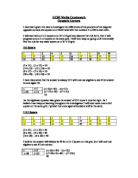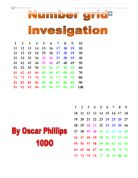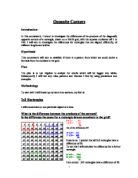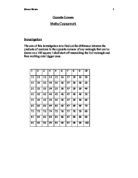I am going to investigate by taking a square shape of numbers from a grid, and then I multiply the opposite corners to find the difference of these two results. Firstly I am going to start with a 10x10 grid
Gcse Math's - number grid coursework I am going to investigate by taking a square shape of numbers from a grid, and then I multiply the opposite corners to find the difference of these two results. Firstly I am going to start with a 10x10 grid and pick up 4 different squares, I will start with the 2x2 square. Then I move on and use the 3x3, 4x4 and the 5x5 square. number Left corner x right corner Right corner x left corner Products difference 3x24=312 4x23=322 0 2 4x25=350 5x24=360 0 3 25x36=900 26x35=910 0 I have noticed that the products difference of 2x2 squares in a 10x10 grid equal to 10. I predict if I move the 2x2 square to the right or down I will get the same answer. 4 34x45=1530 35x44=1540 0 My prediction is right. I am going to use algebra to test my results. n n+1 n+10 n+11 (n+1)(n+10)=n²+10+11n n(n+11)=n²+11n Products difference is equal to (n²+10+11n) - (n²+11n) =10 In the same grid I will now work out a 3x3 square. number Left corner x right corner Right corner x left corner Products difference 5 5x37=555 7x35=595 40 6 6x24=144 4x26=104 40 7 6x38=608 8x36=648 40 I have noticed that the products difference of 3x3 squares in a 10x10 grid equal to 40. I predict if I move the 3x3 square to the right or up I will get the same answer. 8 26x48=1248 28x46=1288 40 My prediction is right. I am going to
Opposite Corners of a Square on a Number Grid
Number Grid - Opposite Corners Investigation Introduction: This task involves pupils investigating the relationship between the results, when diagonally opposite numbers in various sizes of squares are multiplied, and comparing the products. Number Grid - Opposite Corners Investigation Method: . I will use a number grid from 1-100, like the one below, to collect examples of data from different size squares. 2. I will show 4 examples of each size of squares, to confirm each of the differences at the different stages. 3. I will look for a pattern and, if I find one, will explain it fully. 4. I will make a prediction of what I think will happen next and see if it works. 5. I will create an algebraic expression to prove my results. 6. I will then test my algebraic expression on the diagonally opposite corners a rectangle, to see if that works as well. 7. I will then describe the sequence and relationship of the results. 8. I will present my results in a table and write a conclusion. Prediction: I predict that there will be a relevant relationship between the size of the box and the difference in results of the opposite corners. I think there will be a pattern, and an algebraic expression, which will work for all the box sizes. I think this investigation will be one in which you could branch off into many different sections. I think there will be a lot to explore and
I am going to investigate taking a square of numbers from a grid, multiplying the opposite corners and finding the difference of these two results. To start I used a 5x5 grid:
Maths Coursework Number Grids I am going to investigate taking a square of numbers from a grid, multiplying the opposite corners and finding the difference of these two results. To start I used a 5x5 grid: 2 3 4 5 6 7 8 9 0 1 2 3 4 5 6 7 8 9 20 21 22 23 24 25 Then I took 2x2 squares out of this grid and multiplied the opposite corners, to find the difference: 2 6 7 x 7 = 7 2 x 6 = 12 2 - 7 = 5 So the difference between the answers is 5. Next I took another 2x2 square from the same grid. 9 20 24 25 9 x 25 = 475 20 x 24 = 480 480 - 475 = 5 The difference is 5 again. I thought this could mean that all 2x2 squares in a 5x5 grid would come out with a difference of 5. To check this, I took another 2x2 square out of the grid to check. 2 3 7 8 2 x 18 = 216 3 x 17 = 221 221 - 216 = 5 So this shows that my prediction was right and every 2x2 square in a 5x5 grid should come out with a difference of 5. Any 2x2 square in a 5x5 grid = Difference of 5 Now I am going to start taking 2x2 squares out of a 6x6 grid. 2 7 8 x 8 = 8 2 x 7 = 14 4 - 8 = 6 The difference is 6. 21 22 27 28 21 x 28 = 588 22 x 27 = 594 594 - 588 = 6 Again the difference is 6. So I can see like in the 5x5 grid there is a pattern. If I am right every 2x2 square in a 6x6 grid should have a difference of 6. To check if I am right I will take one more square
opposite corners
GCSE Maths Coursework Opposite Corners I have been given the task to investigate the differences of the products of the diagonal opposite corners of a square on a 10x10 Grid with the numbers 1 to 100 to start with. I will start with a 2 x 2 square on a 10 x 10 grid and discover the rule for it, then I will progress onto a 3 x 3 square on the same grid. I will then keep on going until I eventually find the rule for any sized square on a 10 x 10 grid. 2x2 Square 2 3 4 5 6 7 8 9 0 1 2 3 4 5 6 7 8 9 20 21 22 23 24 25 26 27 28 29 30 (2 x 11) - (1 x 12) = 10 (14 x 25) - (15 x 24) = 10 (8 x 17) - (7 x 18) = 10 (20 x 29) - (19 x 30) = 10 I have discovered that the answer is always 10 I will now use algebra to see if the answer is once again 10. n n+1 n+10 n+11 (n+1)(n+10) - n(n+11) (n2+11n+10) - (n2+11n) 0 As the algebraic equation also gives the answer of 10 I know it must be right. As I believe I can keep on learning throughout the investigation I will now move onto a 3x3 square on the same grid. I predict that once again all answers will be the same. 3 X 3 Square 2 3 4 5 6 7 8 9 0 1 2 3 4 5 6 7 8 9 20 21 22 23 24 25 26 27 28 29 30 (3 x 21) - (1 x 23) = 40 (6 x 24) - (4 x 26) = 40 (10 x 28) - (8 x 30) = 40 I believe the answer will always be 40 for a 3 x 3 square on this grid. So I will now use algebra

















